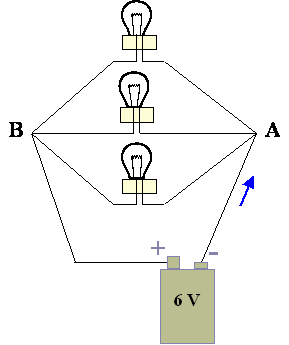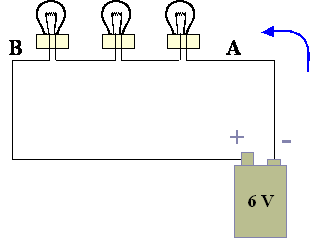Competency #8
Answer and Explanation
![]()
Two circuits are created with identical light bulbs. The first circuit has 3 light bulbs arranged in parallel. The second circuit has 3 light bulbs arranged in parallel. Label each of the following characteristics as “parallel” or “series.”
| Characteristic | Parallel or Series? |
|---|---|
| 1. Voltage across each bulb is equal to the battery voltage | Parallel |
| 2. Current is the same at all points in the circuit | Series |
| 3. If one bulb burns out, all bulbs will go out | Series |
| 4. Overall resistance is higher in this circuit | Series |
| 5. The bulbs shine more brightly in this circuit | Parallel |
| 6. The total current is equal to the sum of the currents in each branch | Parallel |
| 7. This circuit will drain the battery more slowly | Series |
Explanation below:
Shown here are diagrams of a simple parallel circuit (left) and a simple series circuit (right).
 |
 |
Parallel CircuitEach bulb connects the same 2 points, A and B. The 6-Volt battery provides 6 V across each bulb. |
Series CircuitThere is 6 V provided by the battery. There is 2 V across each bulb. |
1. Since each bulb has a direct path to each battery terminal, there will be 6 V across each bulb, which is equal to the battery voltage.
2. In a series circuit, the flow of electrons (current) is the same at all points. Every electron that comes out of the battery must flow through each of the bulbs. In a parallel circuit, the electrons split when they get to point A, with one-third of them going to each light bulb. Thus, each electron only goes through one of the 3 light bulbs. The current is less in the branches of the circuit than they are in the wires connected directly to the battery.
3. In the series circuit, if one bulb goes out, the whole circuit will go out because there is not a continuous flow of electrons to each bulb. In a parallel circuit, if one bulb burns out, it will not interrupt the flow of electrons to the other bulbs. There is still a continuous path the electrons can follow from the battery to the other bulbs and back to the other terminal of the battery.
4. The overall resistance is lower in the parallel circuit because there are more potential pathways for electrons to follow. An analogy for this would be when you are checking out at the supermarket. When more cashiers are open to help customers, there is less resistance to you finishing your shopping experience.
5. As described in #1 above, each bulb in the parallel circuit has 6 V across it. However, the total voltage for the series circuit is also 6 V. Each of the 3 identical bulbs only has 2 V across it. Ohm's law says that current = voltage/resistance.

The resistance is the same for a single bulb in the parallel circuit as it is for a single bulb in the series circuit. Therefore the current will be greater in the parallel circuit and the bulbs in this circuit will shine more brightly.
6. As described in #3 above, when the electrons arrive at point A, they split up, with one-third of the electrons going toward each of the 3 paths. The total of all the electrons leaving point A (and traveling along the three paths) must add up to the total number of electrons that came into point A.
7. As described in #5, there will be greater current in the parallel circuit. Since the electrons are flowing faster in the parallel circuit, the battery (which has a limited ability to provide electrons) will run out more quickly.